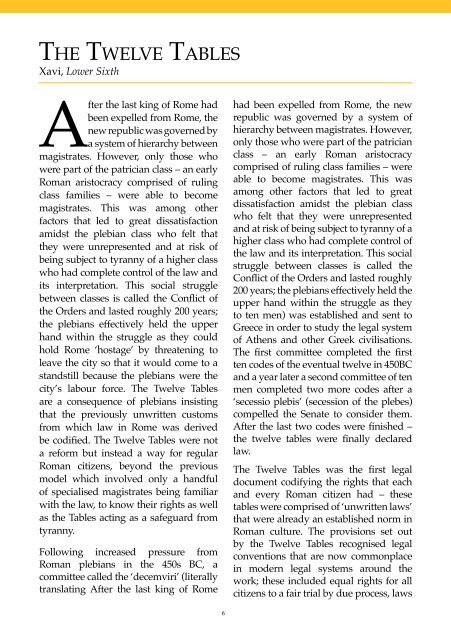Create successful ePaper yourself
Turn your PDF publications into a flip-book with our unique Google optimized e-Paper software.
The Twelve Tables<br />
Xavi, Lower Sixth<br />
After the last king of Rome had<br />
been expelled from Rome, the<br />
new republic was governed by<br />
a system of hierarchy between<br />
magistrates. However, only those who<br />
were part of the patrician class – an early<br />
Roman aristocracy comprised of ruling<br />
class families – were able to become<br />
magistrates. This was among other<br />
factors that led to great dissatisfaction<br />
amidst the plebian class who felt that<br />
they were unrepresented and at risk of<br />
being subject to tyranny of a higher class<br />
who had complete control of the law and<br />
its interpretation. This social struggle<br />
between classes is called the Conflict of<br />
the Orders and lasted roughly 200 years;<br />
the plebians effectively held the upper<br />
hand within the struggle as they could<br />
hold Rome ‘hostage’ by threatening to<br />
leave the city so that it would come to a<br />
standstill because the plebians were the<br />
city’s labour force. The Twelve Tables<br />
are a consequence of plebians insisting<br />
that the previously unwritten customs<br />
from which law in Rome was derived<br />
be codified. The Twelve Tables were not<br />
a reform but instead a way for regular<br />
Roman citizens, beyond the previous<br />
model which involved only a handful<br />
of specialised magistrates being familiar<br />
with the law, to know their rights as well<br />
as the Tables acting as a safeguard from<br />
tyranny.<br />
Following increased pressure from<br />
Roman plebians in the 450s BC, a<br />
committee called the ‘decemviri’ (literally<br />
translating After the last king of Rome<br />
had been expelled from Rome, the new<br />
republic was governed by a system of<br />
hierarchy between magistrates. However,<br />
only those who were part of the patrician<br />
class – an early Roman aristocracy<br />
comprised of ruling class families – were<br />
able to become magistrates. This was<br />
among other factors that led to great<br />
dissatisfaction amidst the plebian class<br />
who felt that they were unrepresented<br />
and at risk of being subject to tyranny of a<br />
higher class who had complete control of<br />
the law and its interpretation. This social<br />
struggle between classes is called the<br />
Conflict of the Orders and lasted roughly<br />
200 years; the plebians effectively held the<br />
upper hand within the struggle as they<br />
to ten men) was established and sent to<br />
Greece in order to study the legal system<br />
of Athens and other Greek civilisations.<br />
The first committee completed the first<br />
ten codes of the eventual twelve in 450BC<br />
and a year later a second committee of ten<br />
men completed two more codes after a<br />
‘secessio plebis’ (secession of the plebes)<br />
compelled the Senate to consider them.<br />
After the last two codes were finished –<br />
the twelve tables were finally declared<br />
law.<br />
The Twelve Tables was the first legal<br />
document codifying the rights that each<br />
and every Roman citizen had – these<br />
tables were comprised of ‘unwritten laws’<br />
that were already an established norm in<br />
Roman culture. The provisions set out<br />
by the Twelve Tables recognised legal<br />
conventions that are now commonplace<br />
in modern legal systems around the<br />
work; these included equal rights for all<br />
citizens to a fair trial by due process, laws<br />
surrounding slander and defamation,<br />
and differentiation between murder and<br />
manslaughter.<br />
The first three tables explore the rights of<br />
citizens concerning trials, due processes in<br />
court and how the judgement of the court<br />
could be exacted. The first table discusses<br />
proceedings between the plaintiff and<br />
defendant; it considers how the court<br />
should respond to various circumstances<br />
such as what to do if the defendant fails to<br />
appear in court or age/sickness prevents<br />
them from doing so. An unusual feature<br />
of this table for modern readers would<br />
be the principle that if either one of the<br />
parties failed to appear at the trial, then<br />
the judge would make their judgement<br />
in favour of the present party no matter<br />
the circumstances. This also formed a<br />
system of timetabling for the trial, as it<br />
was decreed that all trials would end at<br />
sunset. The second table talks further<br />
Above: Appius Claudius Caecus in Senate - Cesare Maccari<br />
about court proceedings – it states that if a<br />
witness failed to show up, then the party<br />
who summoned them could shout and<br />
scream in front of his house every three<br />
days. This table also states that a slave<br />
who committed theft should be flogged<br />
and then thrown to their death off of the<br />
Capitoline Hill cliff.<br />
The third table is most notable for dictating<br />
how to deal with defrauding and areas<br />
surrounding credit. Table III declares that<br />
after 30 days of the debt being unpaid,<br />
then the debtor would be brought to court<br />
by force and the court would then hand<br />
the debtor to the creditor for a period of<br />
up to 60 days, which would most likely<br />
be for labour. The conditions on which<br />
the debtor should be held are also set out<br />
and after the term of 60 days, the debtor<br />
could in some circumstances be sold into<br />
slavery.<br />
The fourth table sets out the rights of<br />
the ‘paterfamilias’ (the patriarch of the<br />
family) which specifically apply to him.<br />
This part of the code contains disturbing<br />
proclamations such as that “dreadfully<br />
deformed” children should be quickly<br />
euthanised by the father and that if a<br />
father tries to sell his son three times, then<br />
the son will automatically become free.<br />
This section also dictates that sons are<br />
born into the inheritance of their family<br />
and that if a boy is born within 10 months<br />
of their suspected father’s death then they<br />
are entitled to the man’s inheritance.<br />
Tables V, VI and X discuss estates,<br />
possession and religion and therefore<br />
largely pertain to women as women at<br />
the time were seen as possessions, which<br />
is evident from the laws surrounding<br />
ownership. Table five is concerned with<br />
guardianship and the wills of citizens;<br />
any inheritance was automatically given<br />
to a man’s sons, however, if he had no<br />
6 7


















